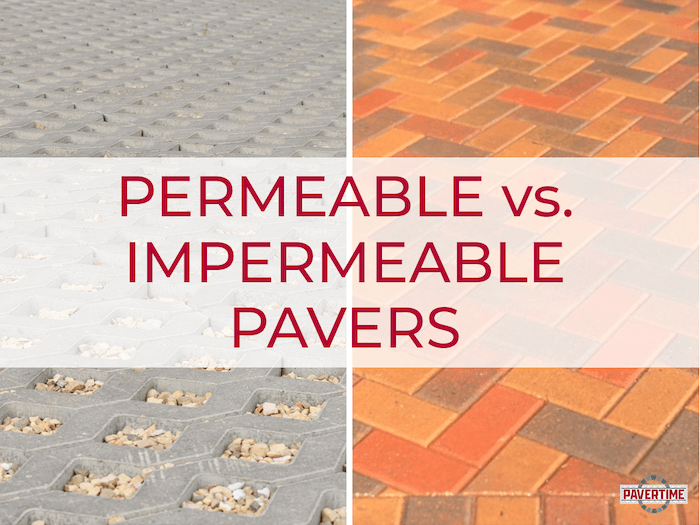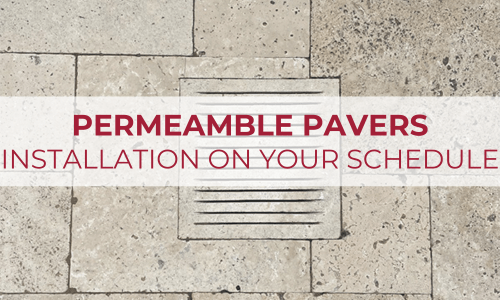A common question posed by our customers is, ‘’What is the difference between permeable pavers vs impermeable pavers?” This question often stems from flooding concerns that are typically at the forefront of homeowners’ minds when they consider their landscaping needs.
For example, the Houston TV station KHOU analyzed 4,418 calls to the City of Houston helpline and determined that several Houston homeowners and neighborhoods suffered from flooding even after a light rainstorm.
This flooding is because Houston was founded in 1836 on the swampy banks of the Buffalo Bayou. You’d think a city built on a bayou would have first-rate drainage systems; unfortunately, that’s not the case.
The city’s drainage systems are old and inadequate for the needs of the metro area. The flooding from Hurricane Harvey demonstrated in 2018, but, as most Houston homeowners know, even a run-of-the-mill rainstorm can cause flooding in Houston neighborhoods.
Pavertime shares your concerns, which is why we’re taking this opportunity to explain three key differences between permeable vs impermeable pavers.
Drainage
A permeable paver is one that is designed to allow water to drain through the layers beneath it. The layers are usually composed of different sizes of rocks that form a holding tank for water. The design of the holding tank depends on the subgrade and the rainfall in the area. The slope of the pavers will also affect the design.
Permeable pavers are made of interconnected pore spaces that allow water to filter into the underlying soil and a special storage layer. This helps prevent flooding. In addition, permeable pavers are often laid on a bed of gravel or sand to further improve their drainage capabilities.
Permeable pavements are also known as green pavement. They reduce stormwater runoff by releasing precipitation slowly into the ground. Permeable pavements also help reduce stormwater pollution by trapping pollutants and allowing them to be used by microbes. Furthermore, plants can grow in these permeable surfaces, which can help prevent flooding and maintain water tables.
Choosing permeable vs impermeable pavers depends on the design of the system. For example, permeable pavers need a thicker base layer. As a result, the subbase layer will require higher bedding. In addition, the gravel base will require a deeper trench.
Infiltration
While both types of paving materials can improve water infiltration, they differ considerably from each other. Permeable paving improves infiltration rates, while impermeable paving would result in lower infiltration. Permeable paving can also help a property owner balance their budgets by saving money on stormwater maintenance fees.
Permeable pavers allow water to seep into the soil and drain away from the driveway. Permeable pavers are built by creating a grid of interconnected cells. This grid is then filled with gravel or other porous material, which allows water to drain through while remaining strong and stable.
This system is ideal for landscaping because it is both aesthetically pleasing and functional, as it prevents water from pooling on the surface and helps to control runoff.
Because the permeable variety does not need a separate drainage system, installation time is shorter. Permeable pavers may be stronger than their impermeable counterparts, but they are no more durable. When installed, they can look nearly identical.
Municipal Codes
The installation of permeable paver systems is regulated by municipal codes. Municipalities can give partial allowances for permeable pavers based on the square footage of the patio, depending on the property’s impervious lot calculation.
An impervious lot calculation is used to determine the percentage of a lot that is covered by impermeable surfaces, such as concrete or asphalt. This information is used to determine the amount of stormwater runoff that will occur from the lot. The calculation is based on the size of the lot and the percentage of impermeable surfaces.
Permeable surfaces, such as pavers, allow stormwater to seep into the ground, reducing the amount of runoff. By contrast, impermeable surfaces, such as concrete or asphalt, prevent stormwater from seeping into the ground, resulting in more runoff. The amount of runoff from an impervious lot can be significant, especially in areas with heavy rainfall.
Some urban municipalities, such as Houston, restrict the amount of runoff that a property can allow. These restrictions can be reduced by replacing impermeable surfaces with permeable ones. These materials help reduce runoff and create sustainable urban drainage systems.
Which Type of Paver is Right for You?
While permeable pavers may appear to be more desirable, they may not fit every budget.
Regular concrete paver installation can run from $12.00 to $24.00 per sq ft depending on materials used. Permeable pavers can run from $17.00 to $30.00 depending on the type of drainage that is required. One system only requires gravel for drainage, but sometimes there is so much water involved that you need to install a drain pipe to take the water away.
The pros and cons of each of these paving solutions should be considered before making a decision.
Some other aspects to consider include the climate, the amount of traffic the area will get, and the overall design of the project. With so many options available, it’s important to work with a professional to choose the right type of permeable paver for your needs.
Pavertime has installed more than 60 permeable driveways and sidewalks. Our team has been trained in the proper installation of these systems by ICPI (Interlocking Concrete Pavement Institute).
We can recommend the best solutions to meet your needs and meet requirements of HOA and city restrictions.
Contact us today to get a free quote or to discuss your landscaping needs further!





